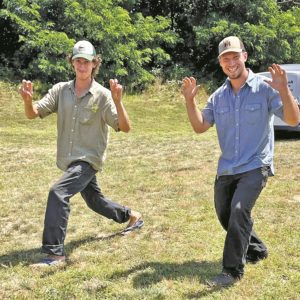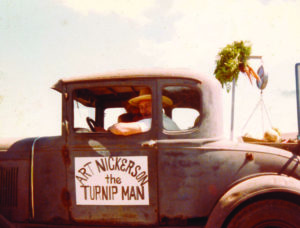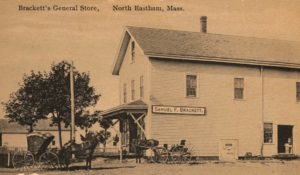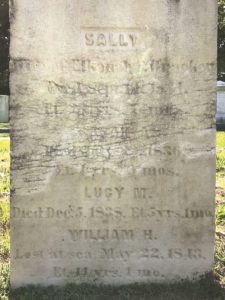EASTHAM — One hundred eleven years ago, the sandy fields of Eastham yielded 10,710 bushels of turnips, more than every other town from Provincetown to Yarmouth combined. When local farmers truck their tubers to the Orleans Farmers Market for Taste of Turnip Day this Saturday, Nov. 20, only one vendor will be selling Eastham-grown Eastham turnips.
“I think we’ll have about 600 turnips,” said Jared Kimler, which comes to about 12 bushels. Kimler is leasing a third of an acre at Redberry Farm, off Schoolhouse Road, with fellow farmer and childhood friend Brian Tingley. Both are 28, which makes them the youngest growers of Eastham turnips this year.

Kimler and Tingley are farmers-in-residence at Halcyon Farm in Brewster, but they decided to plant longer-growing crops like turnips and potatoes in Eastham. Their patch is small and is fenced in to protect it from deer.
Two other farmers will be selling Eastham turnips at Taste of Turnip Day. Brent and Peg Hemeon of Harwich planted about 1.5 acres and have been selling turnips at their farm stand off Bank Street since the beginning of the month. Peter and Dilys Staaterman of Longnook Meadow Farm in Truro started harvesting this week and will also be selling Eastham turnips at their stand.
Otherwise, Eastham turnips may be hard to find. Bob Wells, who owns 5-acre Redberry Farm and usually sells his crop at the annual fest, is not growing turnips this year. There has been no activity at the roadside turnip stand at 5370 State Highway. That property, which is owned by Mary Barnes, is the subject of an unpaid taxes action brought by the town of Eastham in 2017.
The Hemeons and Staatermans reported that heavy autumn rains caused some of their crop to split, and Brent Hemeon had to plant his crop twice this year. Kimler, however, reports that his crop is up to snuff.
“They’re handsome roots,” Kimler said. “In the past 10 days, they’ve been starting to round out. They’re blushing.” After hearing about “turnip mania” for months, the Natick native ate his first Eastham turnip this past weekend, in a mash. He said he now understands the hoopla.
Eastham turnips are going for $4 a pound this season.
For the uninitiated, these are not garden-variety turnips that happen to be grown in Eastham. They are a distinct variety, with purple tops and a sweet flavor. All three of this year’s vendors, and likely every grower of Eastham turnips, can trace their turnips back to Art Nickerson’s field on Aspinet Road. Nickerson saved his seeds long after the rest of the town had moved on from its agricultural origins. In doing so, he saved the Eastham turnip.
Art Nickerson (1915-2008) was born in one Eastham and died in a very different one. When he was a boy, Eastham was still a farm town.
“We were brought up raising turnips,” he said on tape in an interview for a 1982 oral history. He said that every boy in Eastham, “when he was old enough to hold a hoe in his hand, went out and hoed and thinned turnips.” The crops were typically planted after the Fourth of July, once the asparagus crop had been harvested. Just 40 years before his birth, Eastham had 84 farms, one for every eight residents, according to the state census. Art’s brother George said children in Eastham grew up on turnips. “If we got hungry at noontime, we went and raided somebody’s turnip field, peeled a turnip, and ate it raw,” he said in 1988.
During the Great Depression, growing turnips became unsustainable. Farmers who had made a living exporting their crop to Boston found that the market simply disappeared. “The last year my father planted turnips,” said Shirley Williams (née Nickerson) many years later, “they got a bill back for the freight. They didn’t pay anything for his turnips. So that was the end.”
Art Nickerson started growing turnips again in 1975, having somehow saved the seeds. “I hated to see the tradition go away,” he said in 1982. He began selling to local grocers, identifying himself as “The Eastham Turnip Man” when he called the stores. He said that true Eastham turnips had to be grown in the town’s sandy soil, and that aficionados could taste the difference.

Nickerson also took pride in farming the old-fashioned way, with antique planters and a 1949 Ford tractor. He told the Cape Codder in 1993 that “the only thing I do different than in the olden days is that I don’t use a horse. He died.”
When winter came, Nickerson buried his remaining crop and covered it with seaweed to keep the turnips supple and protect them from the frost.
Much to Nickerson’s disappointment, the town did not hold onto the old ways. “When we’re gone, the turnips are gone,” he said on tape. “There is no land to raise them on anymore.”
“I kind of hate to see Cape Cod the way it is now,” interjected Nickerson’s friend Joe King. “We used to go gunning night-times. Ten, 11, 12 o’clock, right down to Sunken Meadow there. Four or five boxes of shells. Ship the ducks in for a dollar apiece to Boston. You can’t do that anymore. See? Didn’t we, Arthur?”
“All I can say,” Nickerson said, “is we knew Cape Cod when Cape Cod was Cape Cod. It’ll never be the same.”




